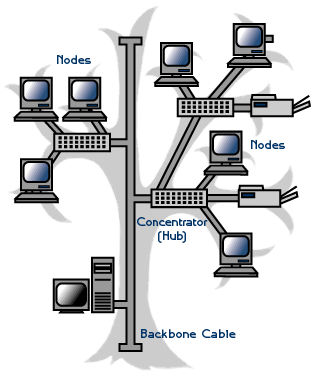UNBOUNDED / UNGUIDED MEDIA
- Unbounded / Unguided media or wireless media doesn't use any physical connectors between the two devices communicating. Usually the transmission is send through the atmosphere but sometime it can be just across the rule. Wireless media is used when a physical obstruction or distance blocks are used with normal cable media. The three types of wireless media are:
·
RADIO WAVES
·
MICRO WAVES
·
INFRARED WAVES
1. RADIO WAVES:-
It has frequency between 10
K Hz to 1 G Hz. Radio waves has the following types.
- Short waves
- VHF (Very High Frequency)
- UHF (Ultra High Frequency)
SHORT WAVES:-
There are different types
of antennas used for radio waves. Radio waves transmission can be divided into
following categories.
- LOW POWER, SINGLE FREQUENCY.
- HIGH POWER, SINGLE FREQUENCY.
- LOW POWER , SINGLE FREQUENCY:-
- As the name shows this system transmits from one frequency and has low power out. The normal operating ranges on these devices are 20 to 25 meter.
CHARACTERISTICS LOW POWER
, SINGLE FREQUENCY:-
- Low cost
- Simple installation with pre-configured
- 1 M bps to 10 M bps capacity
- High attenuation
- Low immunity to EMI
2. HIGH POWER, SINGLE
FREQUENCY:-
- This is similar to low power single frequency. These devices can communicate over greater distances.
CHARACTERISTICS HIGH
POWER, SINGLE FREQUENCY:-
- Moderate cost
- Easier to install than low power single frequency
- 1 Mbps to 10 Mbps of capacity
- Low attenuation for long distances
- Low immunity to EMI
2.MICRO WAVES
Micro waves travels at
high frequency than radio waves and provide through put as a wireless network
media. Micro wave transmission requires the sender to be inside of the
receiver.
Following are the
types of Micro waves.
- · Terrestrial Micro waves
- · Satellite Micro waves
1. Terrestrial Micro
waves:-
- Terrestrial Micro waves are used are used to transmit wireless signals across a few miles. Terrestrial system requires that direct parabolic antennas can be pointed to each other. These systems operate in a low Giga Hertz range.

- Moderate to high cost.
- Moderately difficult installation
- 1 M bps to 10 M bps capacity
- Variable attenuation
- Low immunity to EMI
2.Satellite Micro waves
- Satellite micro wave transmission is used to transmit signals through out the world. These system use satellites in orbit about 50,000 Km above the earth. Satellite dishes are used to send the signals to the satellite where it is again send back down to the receiver satellite. These transmissions also use directional parabolic antenna’ with in line of side.
- In satellite communication micro wave signals at 6 GHz is transmitted from a transmitter on the earth through the satellite position in space. By the time signal reaches the satellites becomes weaker due to 50,000 Km distance. The satellite amplifies week signals and transmits it back to the earth at the frequency less than 6 GHz.
Characteristics
Satellite Micro waves:
- High cost
- Extremely difficult and hare installation.
- Variable attenuation.
- Low immunity to EMI
- High security needed because a signal send to satellite is broadcasts through all receivers with in satellite.
3.Infrared
- Infrared frequencies are just below visible light. These high frequencies allow high sped data transmission. This technology is similar to the use of a remote control for a TV. Infrared transmission can be affected by objects obstructing sender or receiver. These transmissions fall into two categories.
- Point to point
- Broadcast
1. Point to Point: - Point
to point infrared transmission signal directly between two systems. Many lap
top system use point to pint transmission. These systems require direct
alignment between many devices.
Characteristics of Point
to point:-
- Wide range of cost
- Moderately easy installation.
- 100 k bps to 16 Mb of capacity.
- Variable attenuation.
- High immunity to EMI
2. Broad Cast: - These
infrared transmission use sprayed signal, one broad cast in all directions
instead of direct beam. This help to reduce the problems of proper alignment
and abstraction. It also allows multiple receiver of signal
Characteristics of Broad
Cast:-
- In expensive.
- Single installation.
- 1M bps capacity.
- Variable attenuation.
Apa Itu Wi-Fi??...
- Wi-Fi merupakan kependekan dari Wireless Fidelity, yang memiliki pengertian iaitu komplotan standar yang digunakan untuk Jaringan Lokal Nirkabel (Wireless Local Area Networks - WLAN). Awalnya Wi-Fi ditujukan untuk penggunaan perangkat nirkabel dan Jaringan Area Lokal (LAN), namun saat ini lebih banyak digunakan untuk mengakses internet. Ini kerana, wi-fi menghubungkan seseorang dengan komputer melalui kartu nirkabel (wireless card) atau personal digital assistant (PDA) untuk berhubung dengan internet dengan menggunakan titik akses (atau dikenal dengan hotspot) terdekat.
Spesifikasi Wi-Fi
Wi-Fi dirancang
berdasarkan spesifikasi IEEE 802.11. Sekarang ini ada empat variasi dari 802.11
iaitu:-
- 802.11a
- 802.11b
- 802.11g
- 802.11n
Spesifikasi b
merupakan produk pertama Wi-Fi. Variasi g dan n merupakan salah
satu produk yang memiliki penjualan terbanyak pada tahun 2005.
Spesifikasi Wi-Fi
|
|||
Spesifikasi
|
Kecepatan
|
Frekuensi
Band |
Cocok
dengan |
802.11b
|
11
Mb/s
|
~2.4
GHz
|
b
|
54 Mb/s
|
~5 GHz
|
a
|
|
54
Mb/s
|
~2.4
GHz
|
b,
g
|
|
100 Mb/s
|
~2.4 GHz
|
b, g, n
|
|
Wi-fi Hardware
- Hardware wi-fi yang ada di pasaran saat ini ada berupa :
1. PCI
2. USB

















